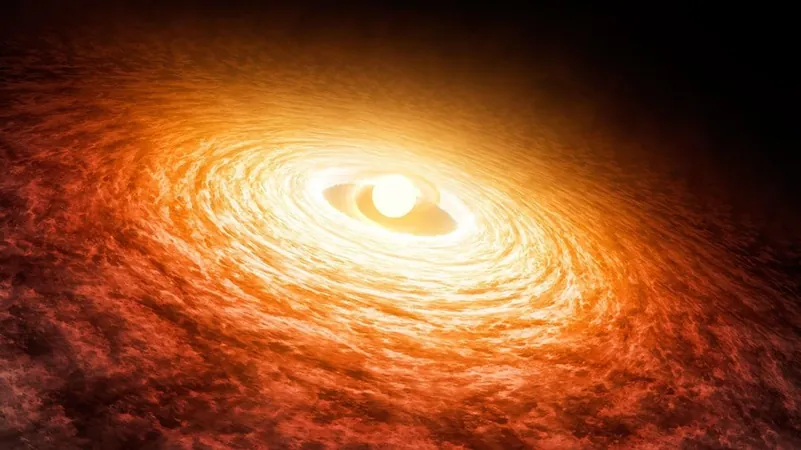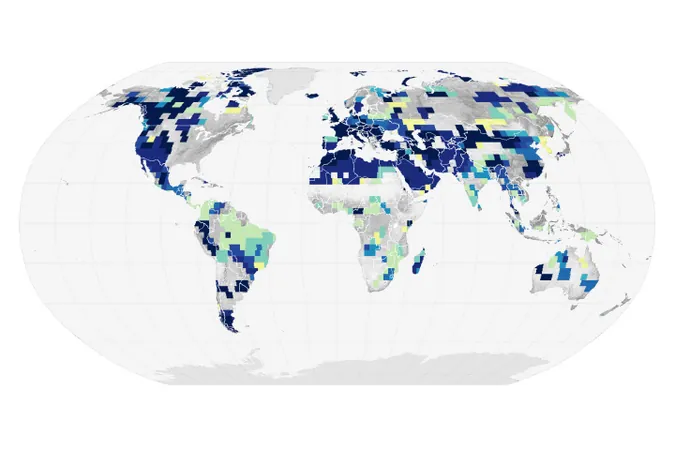
Unlocking the Secrets of FU Orionis: Hubble's Groundbreaking Insights into Stellar Accretion
2024-11-26
Author: William
Introduction
In a stunning astronomical revelation, astronomers are revisiting a century-old enigma surrounding FU Orionis, a peculiar star in the Orion constellation that underwent an astonishing increase in brightness back in 1936. During a short span of months, this dim star became luminous to an extent that was 100 times brighter than our Sun, marking the first observation of such drastic changes in a young star.
Understanding FU Orionis
FU Orionis is a binary star system enveloped by a circumstellar disk—a ring of gas and dust. Its remarkable flare-ups result from the star drawing mass from this disk, leading to episodes of intense brightness. These events have established FU Orionis as the namesake for an entire classification of stars known as FU Ori stars. These stars, which are a subset of T-Tauri stars, are young celestial bodies still in the process of formation, and their brightness fluctuations have intrigued astronomers for decades.
Recent Investigations
While previous research has yielded insights into the accretion processes of FU Ori stars, the intricate dynamics at play between the accretion disk and the star itself have remained elusive. Recent investigations using the Hubble Space Telescope have provided unprecedented observations of these interactions. The findings, published in The Astrophysical Journal Letters by a team led by Adolfo Carvalho, a PhD candidate from Caltech, are shedding light on this fascinating subject.
The Accomplished Research
The researchers focused on the inner edge of FU Orionis’ accretion disk to further understand the boundary layer where the star intersects with its disk. Through their analysis utilizing Hubble’s Cosmic Origins Spectrograph (COS) and Space Telescope Imaging Spectrograph (STIS), they were able to detect a far-ultraviolet accretion shock at the interface—an area previously thought to be challenging to image.
Co-author Lynne Hillenbrand expressed excitement over the results, stating, 'We expected to see some evidence supporting our models, but the brightness exceeded all our predictions. This substantial ultraviolet glare was nothing short of a revelation.'
Differences between FU Ori Stars and Classical T-Tauri Stars
In contrast to classical T-Tauri stars, which have a more stable accretion process governed by magnetic fields, FU Ori stars experience rapid instabilities in their disks, prompting significant fluctuations in accretion rates. This discrepancy allows their accretion disks to extend closer to the star compared to their T-Tauri counterparts, leading to extraordinarily bright outbursts.
Implications of Hubble's Findings
The new data indicates that the region where accretion impacts the stellar surface is significantly hotter than previously anticipated, reaching temperatures around 16,000 kelvins—nearly three times hotter than the Sun’s surface. This shocking discovery prompts a reevaluation of existing models concerning FU Ori stars, challenging astronomers to reassess their understanding of stellar accretion processes.
Moreover, these findings hold broader implications for the formation of exoplanets around such young stars. Researchers speculate that the intense energy and conditions resulting from FU Ori’s flares may influence the chemical makeup of forming planets. According to Carvalho, this presents a complicated interaction: 'Depending on a planet’s distance from the star during these outbursts, its development could be drastically altered. While distant planets may inherit various chemical properties, those forming closer to FU Orionis risk volatile destruction, potentially merging with the star.'
Conclusion
As we delve deeper into the mysteries of FU Orionis, Hubble’s observations pave the way for new discoveries and a richer understanding of how massive celestial systems evolve, providing a window into the birth of stars and the planets that accompany them. The implications of these studies could reshape our knowledge not just of FU Ori stars but the whole process of star and planet formation in the universe. Stay tuned, as this groundbreaking research continues to unfold, revealing the secrets of the universe one stellar mystery at a time!









 Brasil (PT)
Brasil (PT)
 Canada (EN)
Canada (EN)
 Chile (ES)
Chile (ES)
 España (ES)
España (ES)
 France (FR)
France (FR)
 Hong Kong (EN)
Hong Kong (EN)
 Italia (IT)
Italia (IT)
 日本 (JA)
日本 (JA)
 Magyarország (HU)
Magyarország (HU)
 Norge (NO)
Norge (NO)
 Polska (PL)
Polska (PL)
 Schweiz (DE)
Schweiz (DE)
 Singapore (EN)
Singapore (EN)
 Sverige (SV)
Sverige (SV)
 Suomi (FI)
Suomi (FI)
 Türkiye (TR)
Türkiye (TR)